low oil pressure MAZDA MODEL CX-5 2017 Owner's Manual - RHD (UK, Australia) (in English)
[x] Cancel search | Manufacturer: MAZDA, Model Year: 2017, Model line: MODEL CX-5, Model: MAZDA MODEL CX-5 2017Pages: 772, PDF Size: 19.35 MB
Page 262 of 772
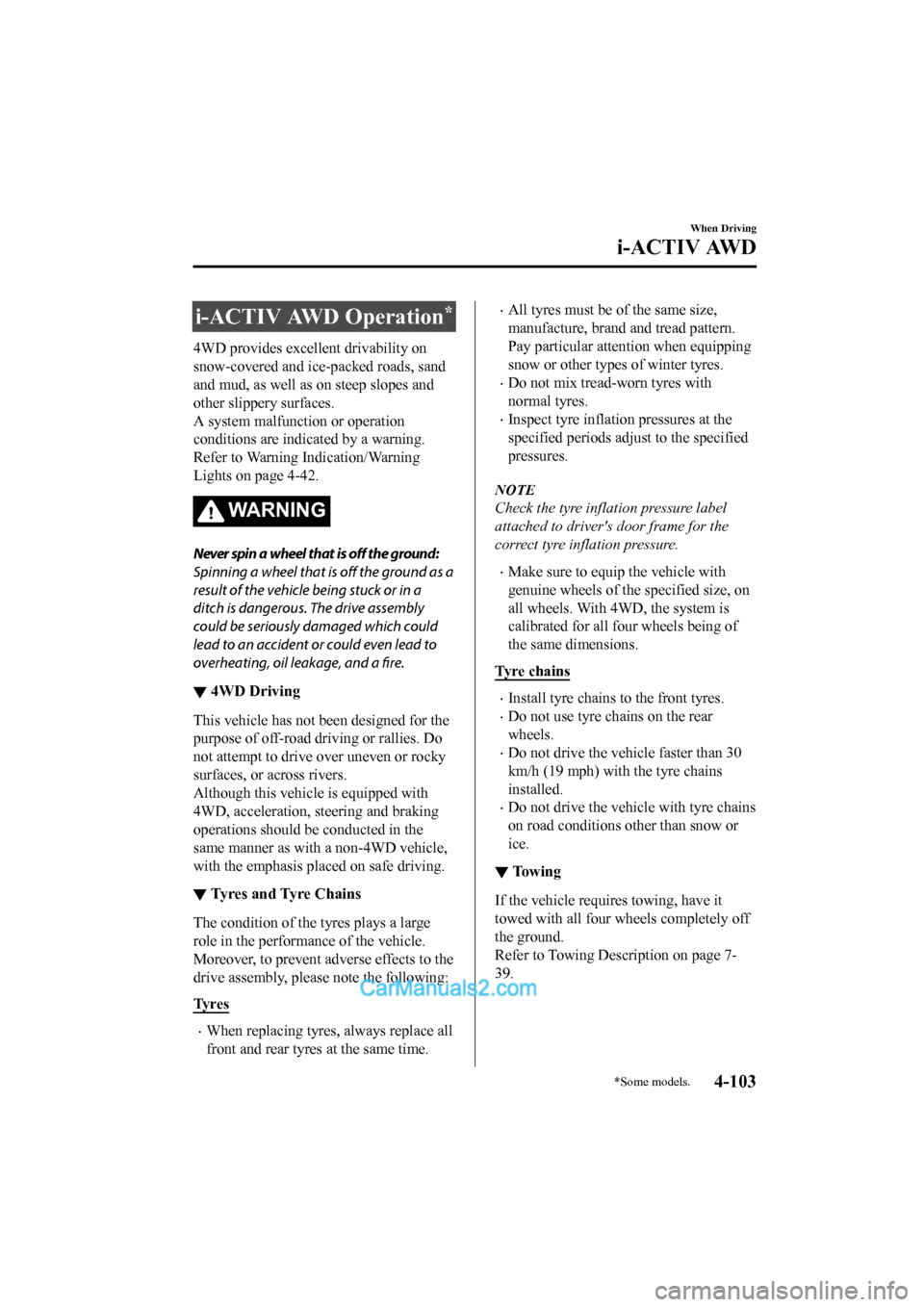
i-ACTIV AWD Operation*
4WD provides excellent drivability on
snow-covered and ice-packed roads, sand
and mud, as well as on steep slopes and
other slippery surfaces.
A system malfunction or operation
conditions are indicated by a warning.
Refer to Warning Indication/Warning
Lights on page 4-42.
WA R N I N G
Never spin a wheel that is off the ground:
Spinning a wheel that is off the ground as a
result of the vehicle being stuck or in a
ditch is dangerous. The drive assembly
could be seriously damaged which could
lead to an accident or could even lead to
overheating, oil leakage, and a fire.
▼ 4WD Driving
This vehicle has not been designed for the
purpose of off-road driving or rallies. Do
not attempt to drive over uneven or rocky
surfaces, or across rivers.
Although this vehicle is equipped with
4WD, acceleration, steering and braking
operations should be conducted in the
same manner as with a non-4WD vehicle,
with the emphasis placed on safe driving.
▼Tyres and Tyre Chains
The condition of the tyres plays a large
role in the performance of the vehicle.
Moreover, to prevent adverse effects to the
drive assembly, please note the following:
Ty r e s
•When replacing tyres, always replace all
front and rear tyres
at the same time.
•All tyres must be of the same size,
manufacture, brand and tread pattern.
Pay particular attention when equipping
snow or other types of winter tyres.
•Do not mix tread-worn tyres with
normal tyres.
•Inspect tyre inflation pressures at the
specified periods adjust to the specified
pressures.
NOTE
Check the tyre inflation pressure label
attached to driver's door frame for the
correct tyre inflation pressure.
•Make sure to equip the vehicle with
genuine wheels of the specified size, on
all wheels. With 4WD, the system is
calibrated for all four wheels being of
the same dimensions.
Ty r e c h a i n s
•Install tyre chains to the front tyres.
•Do not use tyre chains on the rear
wheels.
•Do not drive the vehicle faster than 30
km/h (19 mph) with the tyre chains
installed.
•Do not drive the vehicle with tyre chains
on road conditions other than snow or
ice.
▼ To w i n g
If the vehicle requires towing, have it
towed with all four wheels completely off
the ground.
Refer to Towing Description on page 7-
39.
When Driving
i-ACTIV AWD
*Some models.4-103
2017-6-7 7:51:19 Form No. CX-5 8FY4-EE-17E+L_Edition2
Page 361 of 772

Do not use the front bumper to push other vehi cles or obstructions such as when pulling
out of a parking space. Otherwise, the radar sensor (front) could be hit and its position
deviated.
Do not remove, disassemble, or modify the radar sensor (front).
For repairs, replacement or paint work around the radar sensor (front), consult an
Authorised Mazda Repairer.
Do not modify the suspension. If the suspensi on are modified, the vehicle's posture could
change and the radar sensor (front) may not be able to correctly detect a vehicle ahead or
an obstruction.
NOTE
•Under the following conditions, the
radar sensor (front) may not be able to
detect vehicles ahead or obstructions
correctly and each system may not
operate normally.
•The rear surface of a vehicle ahead
does not reflect radio waves
effectively, such as an unloaded
trailer or an automobile with a
loading platform covered by a soft
top, vehicles with a hard plastic
tailgate, and round-shaped vehicles.
•Vehicles ahead with low vehicle
height and thus less area for
reflecting radio waves.
•Visibility is reduced due to a vehicle
ahead casting off water, snow, or
sand from its tyres and onto your
windscreen.
•The luggage compartment is loaded
with heavy objects or the rear
passenger seats are occupied.
•Ice, snow, or soiling is on the front
surface of the front emblem.
•During inclement weather such as
rain, snow, or sand storms.
•When driving near facilities or
objects emitting strong radio waves.
•Under the following conditions, the
radar sensor (front) may not be able to
detect vehicles ahead or obstructions.
•The beginning and end of a curve.
•Roads with continuous curves.
•Narrow lane roads due to road
construction or lane closures.
•The vehicle ahead enters the radar
sensor's blind spot.
•The vehicle ahead is running
abnormally due to accident or
vehicle damage.
•Roads with repeated up and down
slopes
•Driving on poor roads or unpaved
roads.
•The distance between your vehicle
and the vehicle ahead is extremely
short.
•A vehicle suddenly comes close such
as by cutting into the lane.
•To prevent incorrect operation of the
system, use tyres of the same specified
size, manufacturer, brand, and tread
pattern on all four wheels. In addition,
do not use tyres with significantly
different wear patterns or tyre
pressures on the same vehicle
(Including the temporary spare tyre).
•If the battery power is weak, the system
may not operate correctly.
When Driving
i-ACTIVSENSE
4-202
2017-6-7 7:51:19 Form No. CX-5 8FY4-EE-17E+L_Edition2
Page 562 of 772
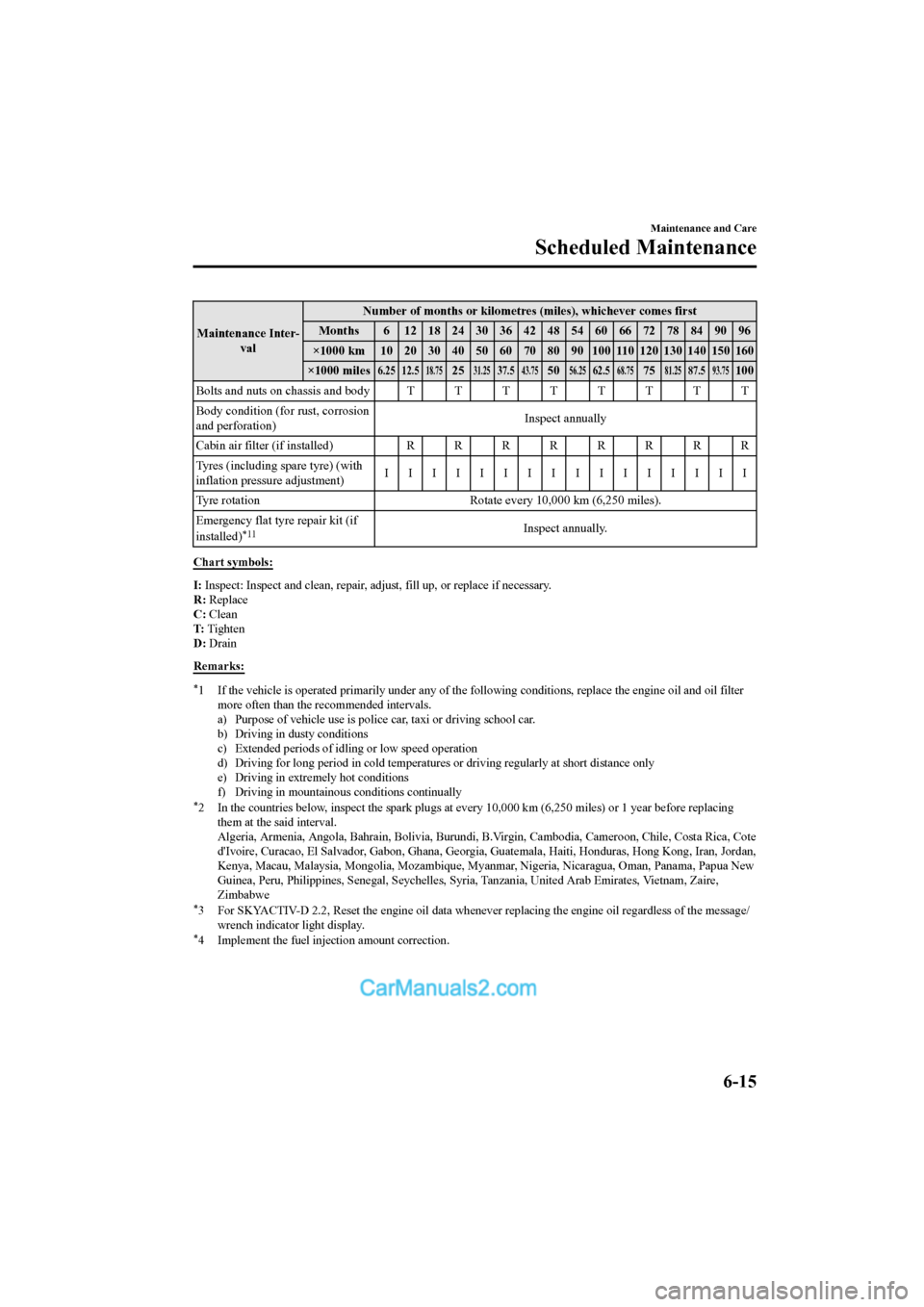
Maintenance Inter-val Number of months or kilometres (miles), whichever comes first
Months 6 121824303642485460667278849096
×1000 km 10 20 30 40 50 60 70 80 90 100 110 120 130 140 150 160
×1000 miles
6.25 12.518.752531.2537.543.755056.2562.568.757581.2587.593.75100
Bolts and nuts on chassis and body T T T T T T T T
Body condition (for rust, corrosion
and perforation) Inspect annually
Cabin air filter (if installed) R R R R R R R R
Tyres (including spare tyre) (with
inflation pressure adjustment) IIIIIIIIIIIIIIII
Tyre rotation Rotate every 10,000 km (6,250 miles).
Emergency flat tyre repair kit (if
installed)
*11Inspect annually.
Chart symbols:
I: Inspect: Inspect and clean, re pair, adjust, fill up, or replac e if necessary.
R: Replace
C: Clean
T: Tighten
D: Drain
Remarks:
*1 If the vehicle is operated primarily under any of the followin g conditions, replace the engine oil and oil filter
more often than the recommended intervals.
a) Purpose of vehicle use is poli ce car, taxi or driving school car.
b) Driving in dusty conditions
c) Extended periods of idling or low speed operation
d) Driving for long period in cold temperatures or driving regul arly at short distance only
e) Driving in extremely hot conditions
f) Driving in mountainous conditions continually
*2 In the countries below, inspect t he spark plugs at every 10,000 km (6,250 miles) or 1 year before replacing
them at the said interval.
Algeria, Armenia, Angola, Bahrain, Bolivia, Burundi, B.Virgin, Cambodia, Cameroon, Chile, Costa Rica, Cote
d'Ivoire, Curacao, El Salvador, G abon, Ghana, Georgia, Guatemala, Haiti, Honduras, Hong Kong, Iran, Jordan,
Kenya, Macau, Malaysia, Mongolia, Mozambique, Myanmar, Nigeria, Nicaragua, Oman, Panama, Papua New
Guinea, Peru, Philippines, Seneg al, Seychelles, Syria, Tanzania, United Arab Emirates, Vietnam, Zaire,
Zimbabwe
*3 For SKYACTIV-D 2.2, Reset the e ngine oil data whenever replacing the engine oil regardless of the message/
wrench indicator light display.
*4 Implement the fuel injection amount correction.
Maintenance and Care
Scheduled Maintenance
6-15
2017-6-7 7:51:19 Form No. CX-5 8FY4-EE-17E+L_Edition2
Page 576 of 772
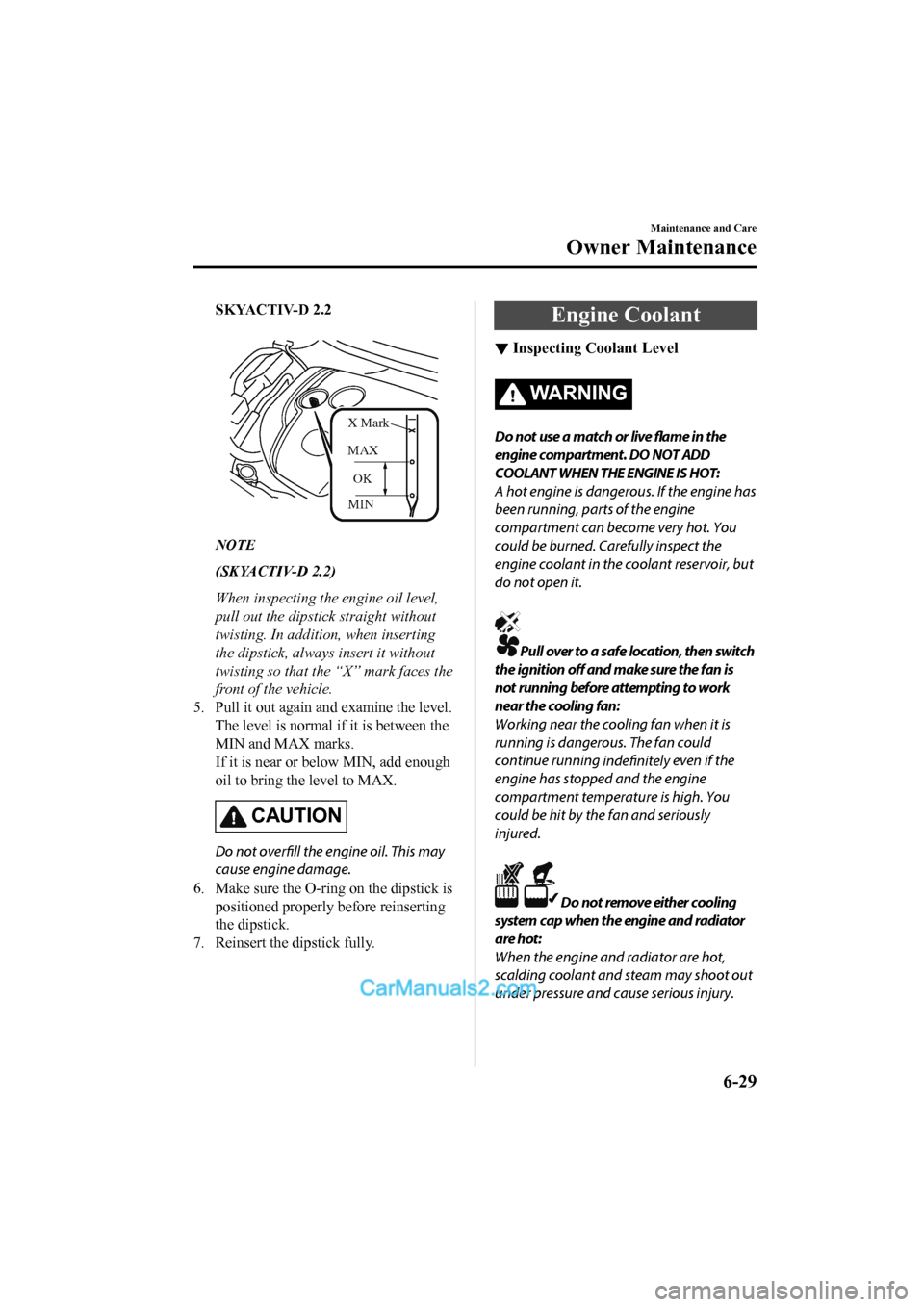
SKYACTIV-D 2.2
MINOK
MAX
X Mark
NOTE
(SKYACTIV-D 2.2)
When inspecting the engine oil level,
pull out the dipstick straight without
twisting. In addition, when inserting
the dipstick, always insert it without
twisting so that the “X” mark faces the
front of the vehicle.
5. Pull it out again and examine the level.
The level is normal if it is between the
MIN and MAX marks.
If it is near or below MIN, add enough
oil to bring the level to MAX.
CAUTION
Do not overfill the engine oil. This may
cause engine damage.
6. Make sure the O-ring on the dipstick is positioned properly before reinserting
the dipstick.
7. Reinsert the dipstick fully.
Engine Coolant
▼ Inspecting Coolant Level
WA R N I N G
Do not use a match or live flame in the
engine compartment. DO NOT ADD
COOLANT WHEN THE ENGINE IS HOT:
A hot engine is dangerous. If the engine has
been running, parts of the engine
compartment can become very hot. You
could be burned. Carefully inspect the
engine coolant in the coolant reservoir, but
do not open it.
Pull over to a safe location, then switch
the ignition off and make sure the fan is
not running before attempting to work
near the cooling fan:
Working near the cooling fan when it is
running is dangerous. The fan could
continue running indefinitely even if the
engine has stopped and the engine
compartment temperature is high. You
could be hit by the fan and seriously
injured.
Do not remove either cooling
system cap when the engine and radiator
are hot:
When the engine and radiator are hot,
scalding coolant and steam may shoot out
under pressure and cause serious injury.
Maintenance and Care
Owner Maintenance
6-29
2017-6-7 7:51:19 Form No. CX-5 8FY4-EE-17E+L_Edition2
Page 611 of 772
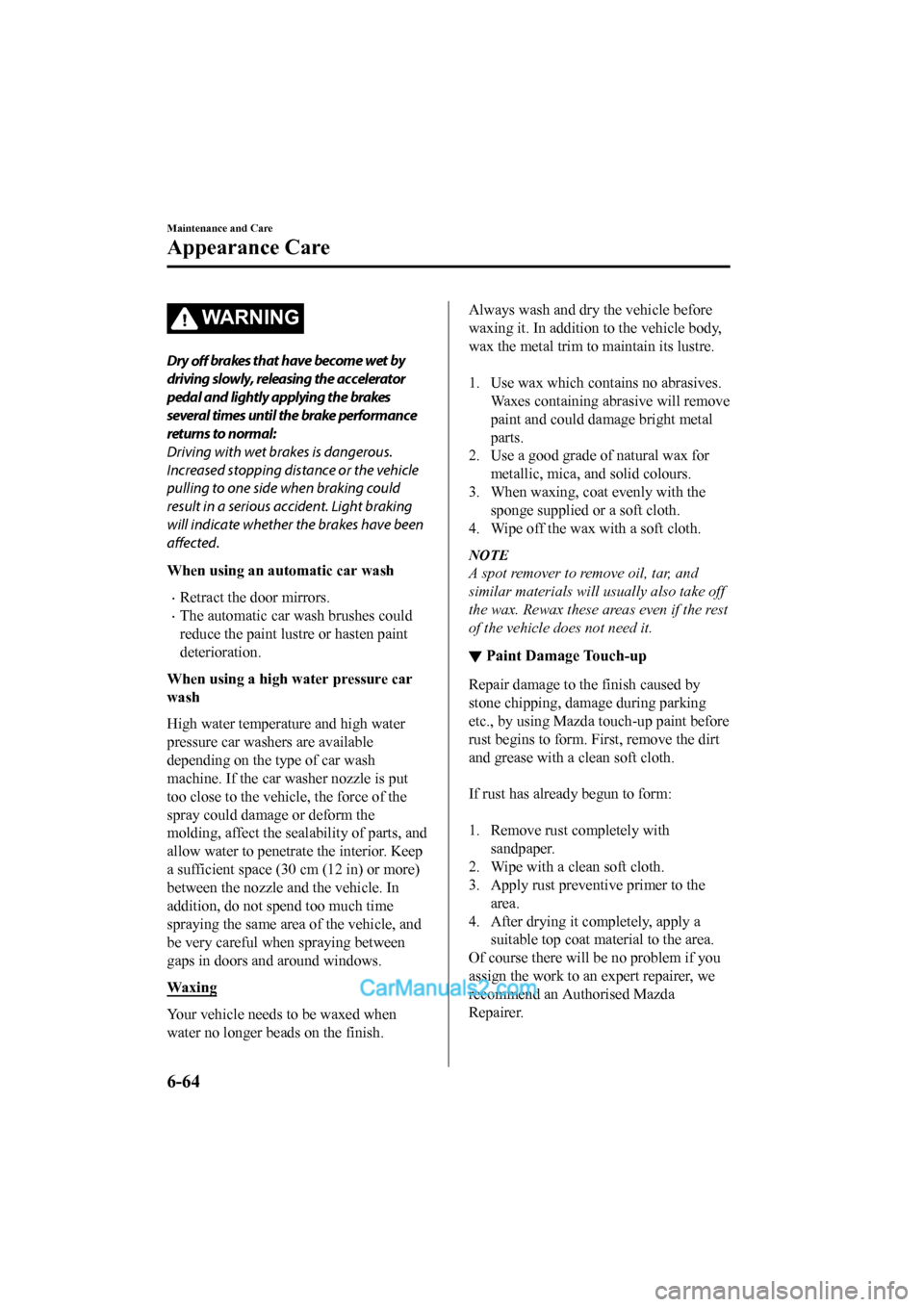
WA R N I N G
Dry off brakes that have become wet by
driving slowly, releasing the accelerator
pedal and lightly applying the brakes
several times until the brake performance
returns to normal:
Driving with wet brakes is dangerous.
Increased stopping distance or the vehicle
pulling to one side when braking could
result in a serious accident. Light braking
will indicate whether the brakes have been
affected.
When using an automatic car wash
•Retract the door mirrors.
•The automatic car wash brushes could
reduce the paint lustre or hasten paint
deterioration.
When using a high water pressure car
wash
High water temperature and high water
pressure car washers are available
depending on the type of car wash
machine. If the car washer nozzle is put
too close to the vehicle, the force of the
spray could damage or deform the
molding, affect the seal ability of parts, and
allow water to penetra te the interior. Keep
a sufficient space (30 cm (12 in) or more)
between the nozzle a nd the vehicle. In
addition, do not spend too much time
spraying the same area of the vehicle, and
be very careful when spraying between
gaps in doors and around windows.
Waxing
Your vehicle needs to be waxed when
water no longer be ads on the finish.
Always wash and dry the vehicle before
waxing it. In addition to the vehicle body,
wax the metal trim to m aintain its lustre.
1. Use wax which contains no abrasives. Waxes containing abrasive will remove
paint and could damage bright metal
parts.
2. Use a good grade of natural wax for
metallic, mica, and solid colours.
3. When waxing, coat evenly with the
sponge supplied or a soft cloth.
4. Wipe off the wax with a soft cloth.
NOTE
A spot remover to remove oil, tar, and
similar materials will usually also take off
the wax. Rewax these areas even if the rest
of the vehicle does not need it.
▼ Paint Damage Touch-up
Repair damage to the finish caused by
stone chipping, damage during parking
etc., by using Mazda touch-up paint before
rust begins to form. F
irst, remove the dirt
and grease with a clean soft cloth.
If rust has already begun to form:
1. Remove rust completely with sandpaper.
2. Wipe with a clean soft cloth.
3. Apply rust preventive primer to the area.
4. After drying it completely, apply a suitable top coat material to the area.
Of course there will be no problem if you
assign the work to an expert repairer, we
recommend an Authorised Mazda
Repairer.
Maintenance and Care
Appearance Care
6-64
2017-6-7 7:51:19 Form No. CX-5 8FY4-EE-17E+L_Edition2
Page 613 of 772
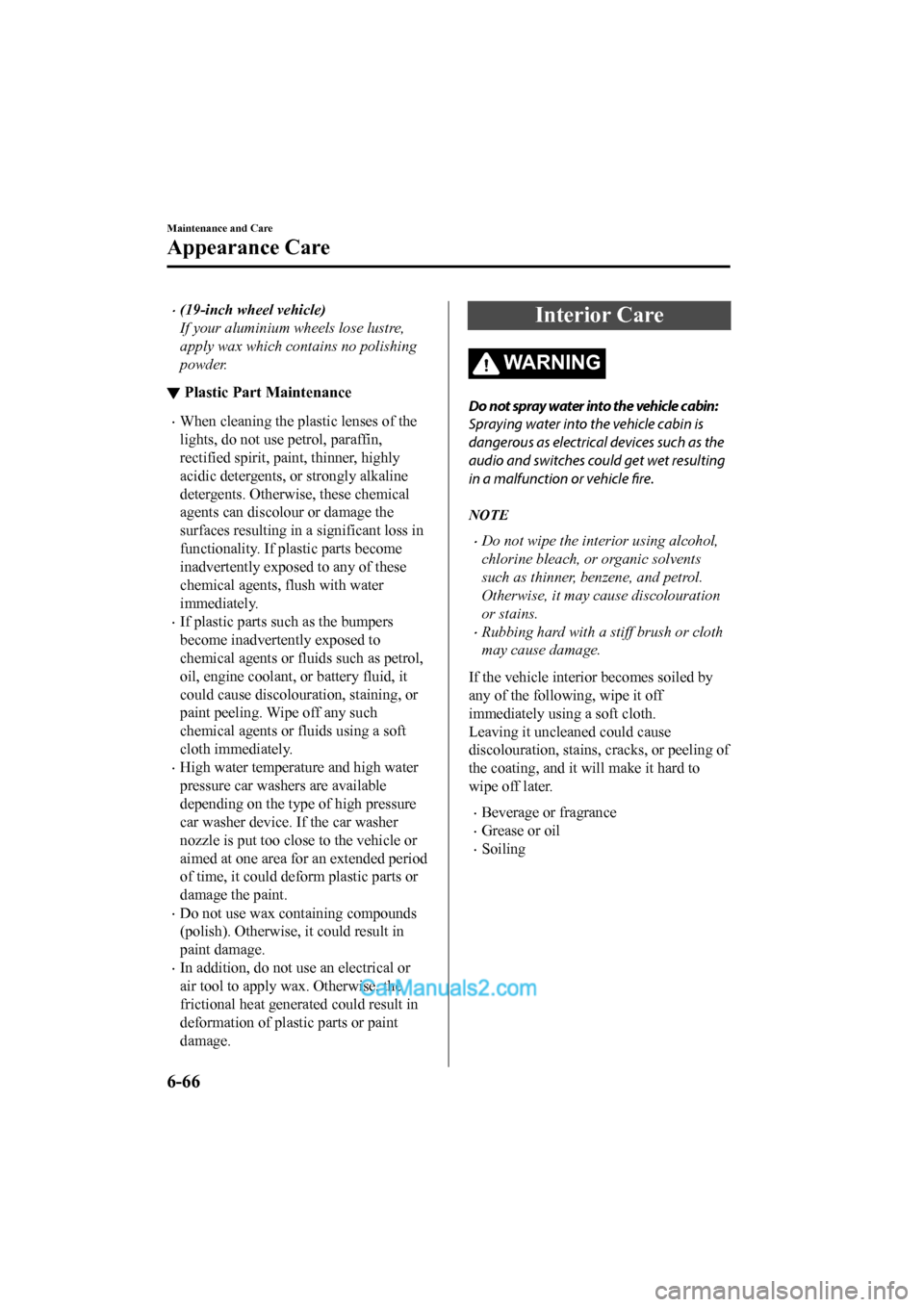
•(19-inch wheel vehicle)
If your aluminium wheels lose lustre,
apply wax which contains no polishing
powder.
▼Plastic Part Maintenance
•When cleaning the plastic lenses of the
lights, do not use petrol, paraffin,
rectified spirit, paint, thinner, highly
acidic detergents, or strongly alkaline
detergents. Otherwise, these chemical
agents can discolour or damage the
surfaces resulting in a significant loss in
functionality. If plastic parts become
inadvertently exposed to any of these
chemical agents, flush with water
immediately.
•If plastic parts s
uch as the bumpers
become inadvertently exposed to
chemical agents or fluids such as petrol,
oil, engine coolant, or battery fluid, it
could cause discolouration, staining, or
paint peeling. Wipe off any such
chemical agents or fluids using a soft
cloth immediately.
•High water temperature and high water
pressure car washers are available
depending on the type of high pressure
car washer device. If the car washer
nozzle is put too close to the vehicle or
aimed at one area for an extended period
of time, it could defo rm plastic parts or
damage the paint.
•Do not use wax containing compounds
(polish). Otherwise, it could result in
paint damage.
•In addition, do not u se an electrical or
air tool to apply wax. Otherwise, the
frictional heat generated could result in
deformation of plastic parts or paint
damage.
Interior Care
WA R N I N G
Do not spray water into the vehicle cabin:
Spraying water into the vehicle cabin is
dangerous as electrical devices such as the
audio and switches could get wet resulting
in a malfunction or vehicle fire.
NOTE
•Do not wipe the interior using alcohol,
chlorine bleach, or organic solvents
such as thinner, benzene, and petrol.
Otherwise, it may cause discolouration
or stains.
•Rubbing hard with a stiff brush or cloth
may cause damage.
If the vehicle interior becomes soiled by
any of the following, wipe it off
immediately using a soft cloth.
Leaving it uncleaned could cause
discolouration, stains, cracks, or peeling of
the coating, and it will make it hard to
wipe off later.
•Beverage or fragrance
•Grease or oil
•Soiling
Maintenance and Care
Appearance Care
6-66
2017-6-7 7:51:19 Form No. CX-5 8FY4-EE-17E+L_Edition2
Page 647 of 772
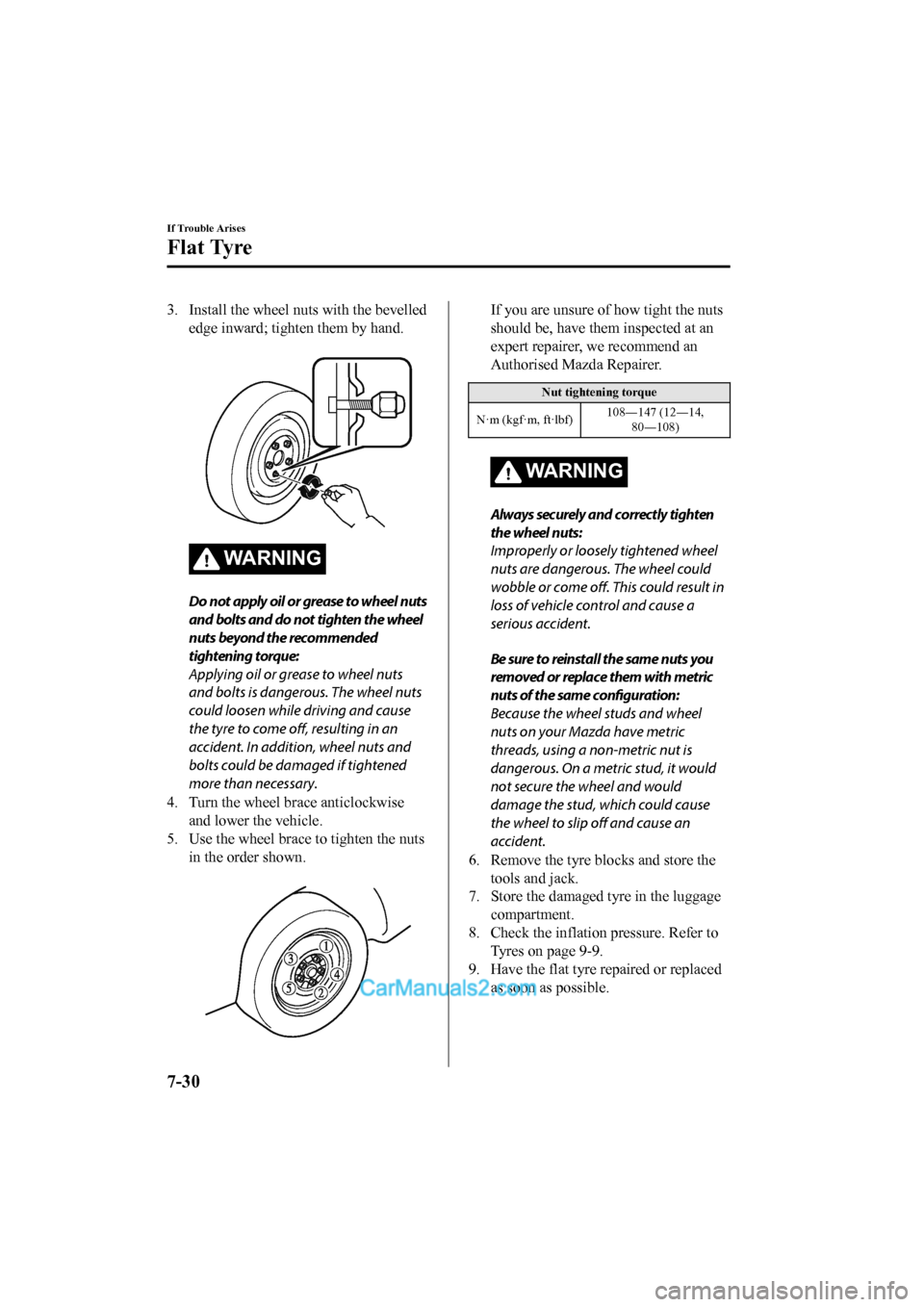
3. Install the wheel nuts with the bevellededge inward; tighten them by hand.
WARNING
Do not apply oil or grease to wheel nuts
and bolts and do not tighten the wheel
nuts beyond the recommended
tightening torque:
Applying oil or grease to wheel nuts
and bolts is dangerous. The wheel nuts
could loosen while driving and cause
the tyre to come off, resulting in an
accident. In addition, wheel nuts and
bolts could be damaged if tightened
more than necessary.
4. Turn the wheel brace anticlockwise and lower the vehicle.
5. Use the wheel brace to tighten the nuts in the order shown.
If you are unsure of how tight the nuts
should be, have them inspected at an
expert repairer, we recommend an
Authorised Mazda Repairer.
Nut tightening torque
N·m (kgf·m, ft·lbf) 108―147 (12―14,
80―108)
WARNING
Always securely and correctly tighten
the wheel nuts:
Improperly or loosely tightened wheel
nuts are dangerous. The wheel could
wobble or come off. This could result in
loss of vehicle control and cause a
serious accident.
Be sure to reinstall the same nuts you
removed or replace them with metric
nuts of the same configuration:
Because the wheel studs and wheel
nuts on your Mazda have metric
threads, using a non-metric nut is
dangerous. On a metric stud, it would
not secure the wheel and would
damage the stud, which could cause
the wheel to slip off and cause an
accident.
6. Remove the tyre blocks and store the tools and jack.
7. Store the damaged tyre in the luggage compartment.
8. Check the inflation pressure. Refer to Tyres on page 9-9.
9. Have the flat tyre repaired or replaced as soon as possible.
If Trouble Arises
Flat Tyre
7-30
2017-6-7 7:51:19 Form No. CX-5 8FY4-EE-17E+L_Edition2
Page 661 of 772
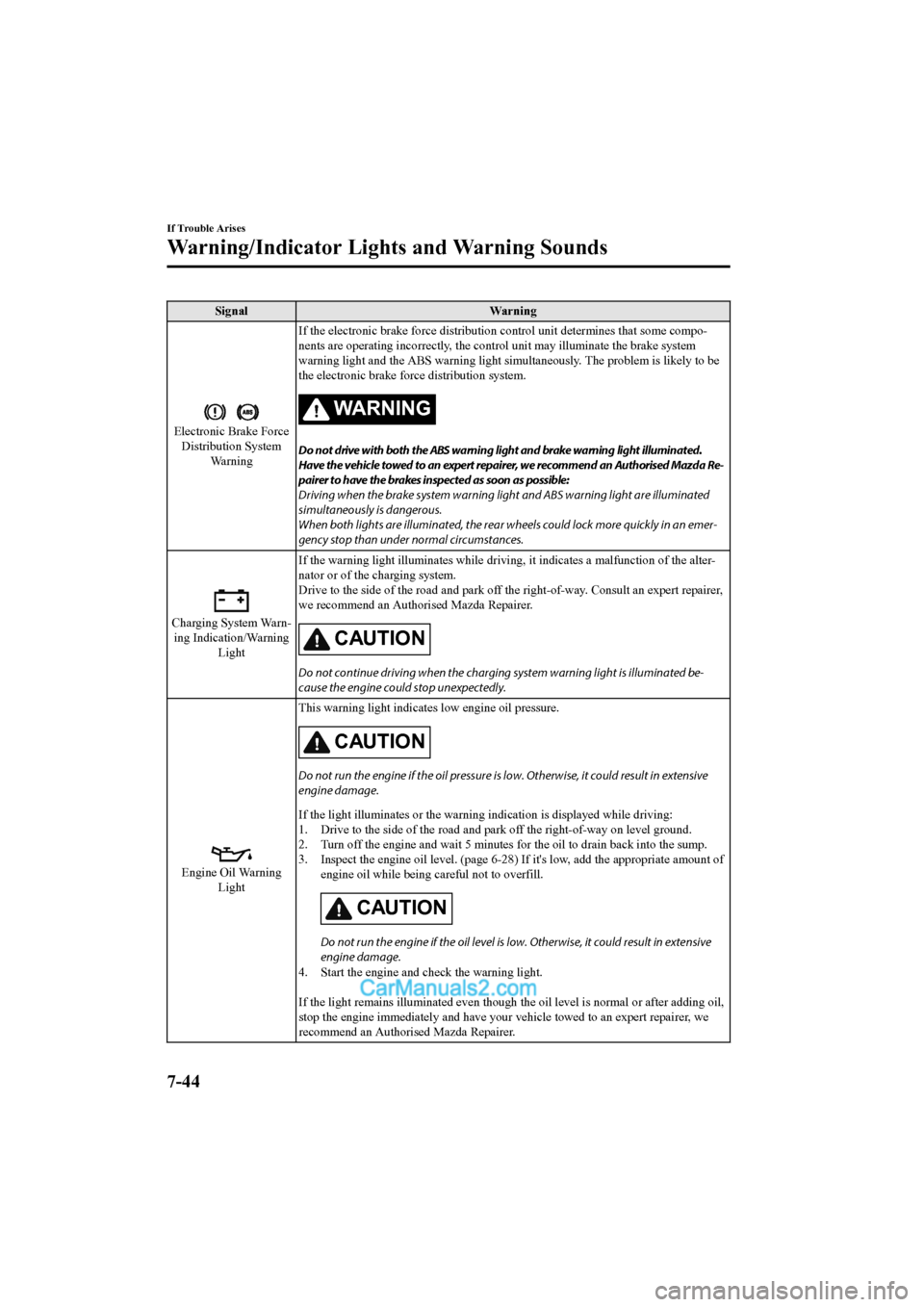
SignalWarning
Electronic Brake Force
Distribution System Wa r n i n g If the electronic brake force di
stribution control unit determines that some compo-
nents are operating incorrectly , the control unit may illuminate the brake system
warning light and the ABS warni ng light simultaneously. The problem is likely to be
the electronic brake force distribution system.
WARNING
Do not drive with both the ABS warning light and brake warning light illuminated.
Have the vehicle towed to an expert repairer, we recommend an Authorised Mazda Re‐
pairer to have the brakes inspected as soon as possible:
Driving when the brake system warning li ght and ABS warning light are illuminated
simultaneously is dangerous.
When both lights are illuminate d, the rear wheels could lock more quickly in an emer‐
gency stop than under normal circumstances.
Charging System Warn- ing Indication/Warning Light If the warning light illuminates while driving, it indicates a
malfunction of the alter-
nator or of the charging system.
Drive to the side of the road and park off the right-of-way. Co nsult an expert repairer,
we recommend an Author ised Mazda Repairer.
CAUTION
Do not continue driving when the charging system warning light is illuminated be‐
cause the engine could stop unexpectedly.
Engine Oil Warning Light This warning light indicates low engine oil pressure.
CAUTION
Do not run the engine if the oil pressure is
low. Otherwise, it could result in extensive
engine damage.
If the light illuminates or the w arning indication is displayed while driving:
1. Drive to the side of the road and park off the right-of-way o n level ground.
2. Turn off the engine and wait 5 minutes for the oil to drain b ack into the sump.
3. Inspect the engine oil level. (page 6-28) If it's low, add th e appropriate amount of
engine oil while being careful not to overfill.
CAUTION
Do not run the engine if the oil level is low. Otherwise, it could result in extensive
engine damage.
4. Start the engine and check the warning light.
If the light remains illuminated even though the oil level is normal or after adding oil,
stop the engine immediately and have your vehicle towed to an expert repairer, we
recommend an Authorised Mazda Repairer.
If Trouble Arises
Warning/Indicator Lights and Warning Sounds
7-44
2017-6-7 7:51:19 Form No. CX-5 8FY4-EE-17E+L_Edition2